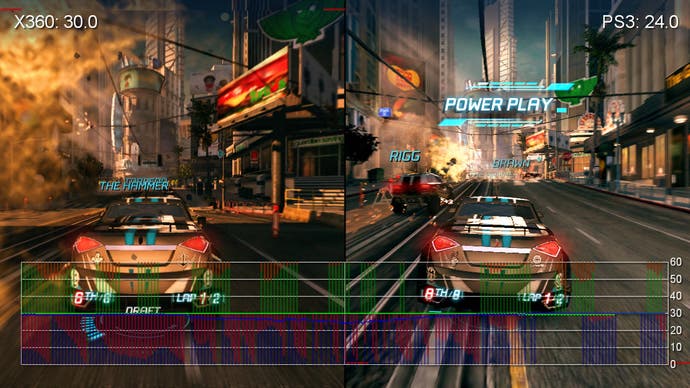Xbox 360 vs. PlayStation 3: Round 26
Split/Second, Lost Planet 2, Green Day: Rock Band, Prince of Persia and Backbreaker.
Another month, another multi-game Xbox 360 vs. PlayStation 3 Face-Off. Let's get the party started with all the stats, videos, comparison galleries and performance analyses you crave, derived from an eye-watering array of big names and quality wares.
Thankfully the mania of the release schedule diminishes as we enter summer, perhaps allowing us to do some catch-up coverage on other titles, but the immediate future is E3: Project Natal, Move, Nintendo 3DS, OnLive, Gaikai, and masses of AAA titles for us to preview. Woo! In the meantime, let's get this show on the road.
Split/Second: Velocity
| Xbox 360 | PlayStation 3 | |
|---|---|---|
| Disc Size | 6.6GB | 6.48GB |
| Install | 6.6GB (optional) | 3774MB (mandatory) |
| Surround Support | Dolby Digital | Dolby Digital, 5.1LPCM, 7.1LPCM, Dolby Digital, DTS |
We've been blessed recently with the release of two superb-looking racing games on the HD consoles.
Activision's Blur has already been covered in some depth, and now the focus shifts to Black Rock's unashamedly blockbuster-style driving game: Split/Second.
Whereas the Bizarre game focuses on power-ups and car-to-car battling, Split/Second makes the environment the weapon of choice, with its 'powerplays' causing scenery-destructing set-pieces of varying scale.
It's a tough call to get a game like this operating in a like-for-like manner on two completely different architectures, but it's fair to say that Black Rock has done some good work, as you can see in the requisite comparison movie:
Aside from a small resolution deficit on Xbox 360, the games are very similar, and both feature 2x multi-sampling anti-aliasing, although the effectiveness of the edge-smoothing seems to vary according to the effects in play, and indeed changes cross-platform. Tree foliage doesn't seem to get AA on PS3, for example.
We took at a look at demo performance on the two games a while back and concluded that they were very similar but with a small, noticeable performance boost for the Xbox 360 version.
So how does this translate into the full game? Here's a selection of action from the mid-point of the Split/Second "season".
Overall impressions are that not a huge amount has changed from the demo. Both games operate at a fairly solid 30 frames per second, but both are prone to screen-tear.
However, it's clear that the PS3 version has the most performance issues, and the tearing has more of an impact on the image quality.
Take a look at the graph again and notice the location of the tears - you'll see that the Xbox 360 game generally keeps them at the top of the screen unless something really big and crazy is going off, whereas the PS3 game will see far more noticeable cascades down the display.
For the most part the frame-rate remains constant at 30FPS, but the PS3 tearing cascade does give the impression of a less stable, "wobbling" image. Certain tracks and events see an even larger performance gap and there are some frame-rate drops, as you can see in these two shots taken from the analysis.


Other differences are less important but notable nonetheless. For example, the Xbox 360 version features a higher level of post-processing in environments at further distances compared to the PS3 game.
This sense of smoothing is probably a good thing bearing in mind that the native framebuffer resolution of the 360 game is 1280x672 (as confirmed in the DF tech interview), up against native 720p on PS3. "Cleaner" lines would show more upscaling artifacts.
The overall impression is that PS3 often looks sharper but with more apparent jaggies. However, this sensation is down to the post-processing effects on 360 being somewhat more refined or aggressive, depending on your perspective. Motion-blur blending certainly looks better on 360.
The particle buffer has also been cut down. Both versions have low-resolution smoke, but the PS3's alpha buffer seems to be running with a pared-down horizontal resolution, leading to the occasional odd-looking artefact you don't see on 360.
It's only really noticeable in still shots, but all of these factors combine to create a look that's smoother and more refined on 360, even with the drop in vertical resolution.
It's clear that Black Rock has achieved what it set out to do with Split/Second - dynamic, complex environment effects transposed into Burnout-style gameplay. It's wonderfully over-the-top and flashy, and the track-changing level-two powerplays offer lots of replay potential - just to see the many variations inherent in each track.
In this sense, it's clearly a case of mission accomplished for both versions, with the original Eurogamer review proving to be good criticism that encompasses Split/Second on both consoles.
However, it's 360 that gets the nod from Digital Foundry, simply down to the more consistent performance level in all areas of the game, along with the fact that the screen-tear is not as much of an issue as it is on the PS3 version.
The performance factor in terms of frame-rate does have a direct knock-on effect on gameplay, too - I found that maintaining power drifts was much more of a difficult task when the game framed out, and visual feedback was not consistent.
Split/Second's still a good game on both systems, and an interesting alternative to Bizarre Creations' Blur, but the cross-platform development work isn't quite to the same level.







